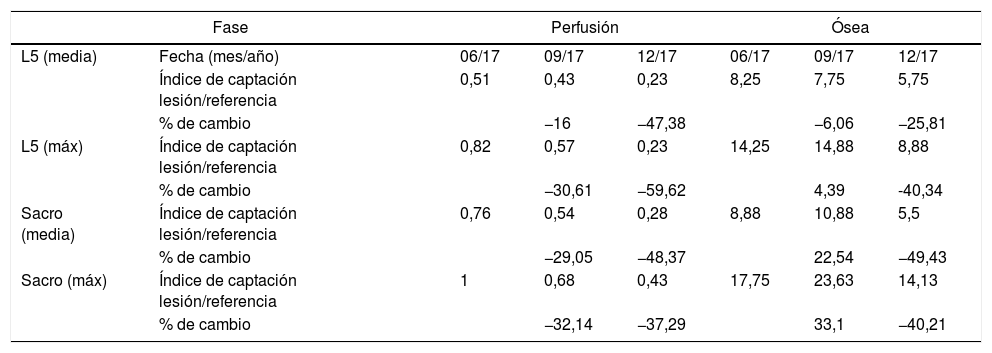Reportamos el caso de una paciente con cáncer de mama, en la que la PET/TC ósea doble fase con 18F-fluoruro de sodio (18F-NaF) resultó de utilidad para detectar metástasis óseas ocultas y valorar la respuesta al tratamiento. La paciente fue estudiada con PET/TC ósea en doble fase de una lesión de nuevo desarrollo detectada en la gammagrafía posterior a la intervención. En las imágenes PET/TC de perfusión y óseas, se encontraron captaciones en las fases de perfusión y ósea, puntualmente incrementadas en el sacro y la vértebra L5, sugerentes de metástasis óseas del cáncer de mama, por lo que se aplicó a la paciente terapia paliativa. En las imágenes de PET/TC ósea en doble fase, realizadas a los 3y 6meses, las imágenes de perfusión reflejaron más claramente la mejora de la captación de la lesión que las imágenes de la fase ósea en los análisis visual y semicuantitativo. Por tanto, se utilizaron las imágenes de la fase de perfusión para esclarecer la respuesta a la terapia con mayor prontitud que las imágenes de la fase ósea. Se trata del primer caso que refleja la utilidad clínica de la PET/TC ósea con 18F-NaF, con la técnica de imagen de perfusión, para evaluar las metástasis óseas y la respuesta terapéutica de las lesiones óseas metastásicas.
We report the case of a breast cancer patient in whom a two-phase 18F-sodium-fluoride (18F-NaF) bone PET/CT was useful for detecting hidden bone metastases and assessing treatment response. The patient underwent a two-phase bone PET/CT to evaluate a newly developed lesion found on bone scintigraphy following surgery. In the perfusion and bone phase PET/CT images, focally increased perfusion and bony uptake were found in the sacrum and L5 vertebra, suggesting bone metastases of breast cancer. Therefore, the patient subsequently underwent palliative treatment. In another twoPET/CT studies (each including two-phase bone images) performed after 3and 6months of follow-up, the perfusion phase images showed an improvement of the lesion uptake more clearly than in the bone phase images in the visual and semi-quantitative analyses, and thus the perfusion phase images were more useful for clarifying the treatment response earlier than the bone phase images. This is the first case showing the clinical usefulness of 18F-NaF bone PET/CT with the perfusion imaging technique for evaluating bone metastases and the therapeutic response of metastatic bone lesions.
Artículo
Comprando el artículo el PDF del mismo podrá ser descargado
Precio 19,34 €
Comprar ahora










